Advice on “Seeing” as an Artist and How to Paint Landscapes (Plein Air and Studio)
A recent address delivered to one of my classes on how to paint landscapes:
The other day I spoke to you about a new way of seeing, that is guaranteed to change your painting forever! Now I want to explain what I mean. (First let me say that this is not really anything new, just new to those who have not been exposed to this idea before.) To illustrate this, I need to contrast how a novice sees things, compared to a seasoned artist, in hopes of helping each of you break the barriers in your own artistic development that keep you from progressing. As I’ve stated, this new way of seeing is key to your success, and the development of this skill will do more to further your advancement as a painter than anything else. Also, I want you to know that just being aware of this skill is not the same as possessing it, or possessing it fully. In my own quest for artistic expression, I am still developing my understanding of this concept, and I don’t claim to have all the answers. I’m sure that this quest for excellence is what keeps me going!
Ok, if there is a new way of seeing, there must also be an old way of seeing, right? The way I see it, no pun intended, is that the old way of seeing goes something like this. The student arrives on a location, with paints in hand, and exclaims: “Wow, look at that! I like it, I want to paint it!” The only problem is, the “it” that they want to paint, is often a feeling about the subject that could be due to a nostalgic reaction or possibly their excitement about certain colors or even a heightened love of nature, that overwhelms their vision of how to proceed. The scene itself, may even lack real design possibilities to base a painting on.
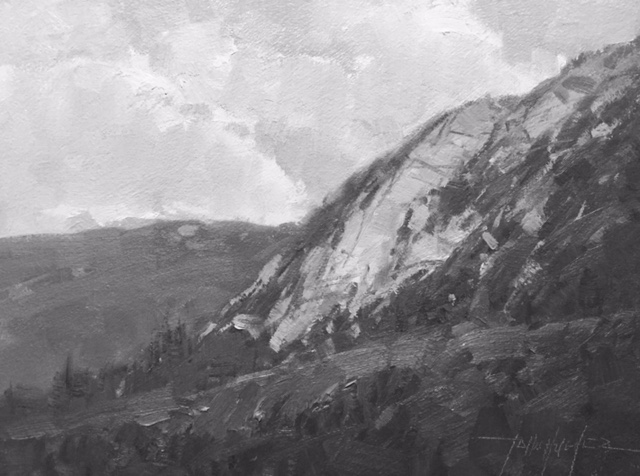
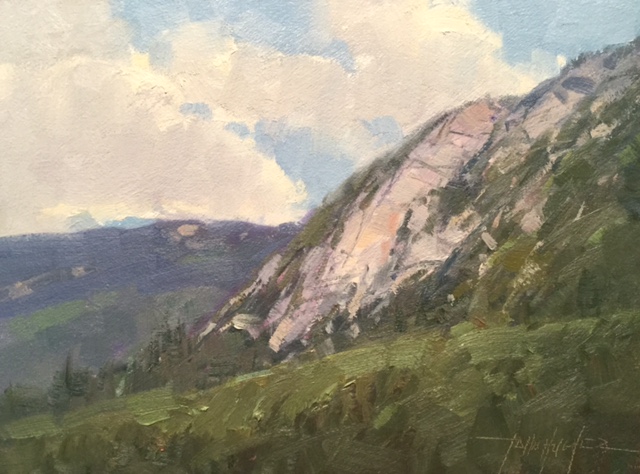
Scene selection is a huge factor in the success of any landscape painter, and can’t be stressed enough! Some scenes are attractive, by the post card definition, but lack the essential elements that would make a good painting. More on this in a minute…
So the real challenge then, is not only to see differently, as the title of this piece suggests, but to first be able to artistically select a subject, and then paint differently as well.
How to Paint Landscapes: What is the answer?
It all sounds like a tall order, until we break it down into smaller digestible chunks of information. First, let’s take the “seeing” part before moving on to execution and scene selection. I will explain this bewildering order in a moment. But first, let’s go back to the old way of seeing, in order to make the contrast.
The old way is to look at the scene and start to identify all of the component parts in laundry list fashion. Perhaps your scene has some prominent trees, a lake, a mountain, a few rocks, a beaver, a deer, and a woman feeding geese! You can see how identifying all these objects and putting them in your painting might create some problems associated with a unified theme. So the first object of the artist, is to decide what that theme is, and eliminate all of the things that distract from it. Just because something is there in front of you, doesn’t mean you have to paint it!
For more advice on how to paint landscapes,
sign up for the Plein Air Today newsletter!
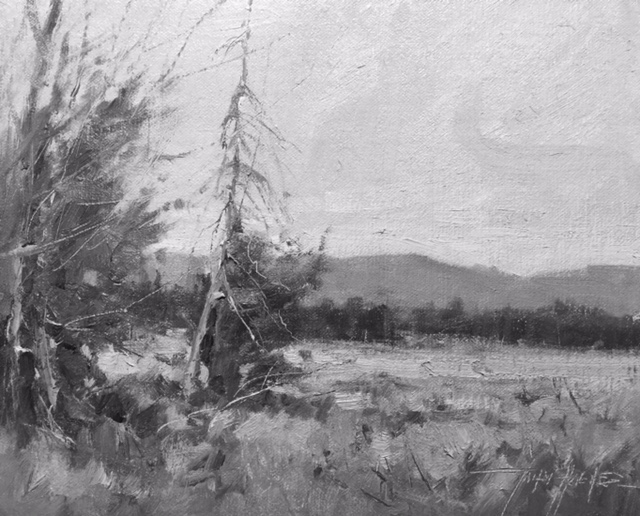
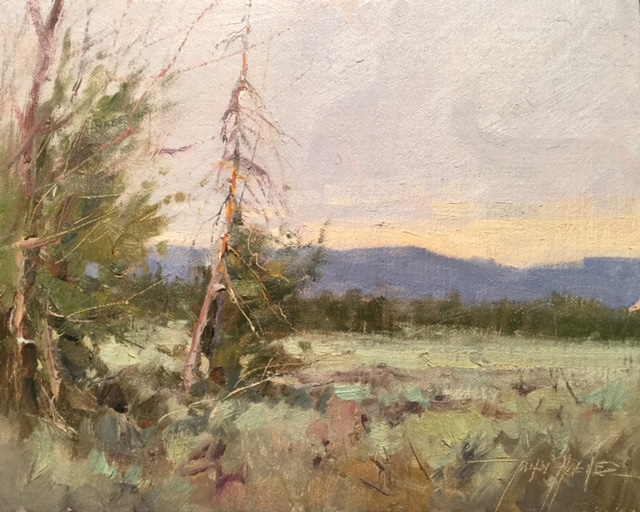
Ok, let’s say you have gotten to this point, and you have decided to paint the trees, mountain, rocks, and the lake. Discarded, are the woman feeding the geese, the deer and beaver. Now you have at least simplified the scene to only what is important to you.
Your next step is to see differently! Huh? Yes, see differently! Instead of seeing the scene as a collection of “things” i.e., the mountain, rocks, lake and trees; what if you were to view them as shapes and values instead? First of all, you would begin to group the visual information differently; think two dimensionally here. Instead of singling out the trees separately, you might see them as a grouping, and the shadows they cast as one shape instead of many. You might even be able to see this shape connected to the dark value of the lake; therefore making your first marks on the canvas reflect your vision of this big abstract shape instead of, again, the laundry list.
For this to work effectively, think of the value patterns in terms of 3s, these are, your darks, mid-tones and lights. Normally, we work with 9 values on a value scale, but you shouldn’t start with all of them, save those refinements for later. Thinking in terms of just three values is a way of simplifying the information in front of you, and then putting it on the canvas in a broadly painted way.
(Note about How to Paint Landscapes – Thinking this way might be aided by the use of a monochromatic block-in, using one color such as raw umber or burnt sienna only. Your mid-tone could be rubbed on the whole canvas surface with a cloth right away, leaving only the darks and light shapes to work out next.)
After laying in the darks with this color, move on to the light shining on the rocks, grouping them as one continuous shape, or a trail of separate, but related shapes, rather than unrelated objects. Placing the lights can be accomplished by wiping them out with a rag, which is either dry, or slightly moistened with mineral spirits. You can also do this with a solvent soaked brush or combination of the two. Again, you might even be able to extend these shapes to include other lights in the scene of similar value.
Now that you have done that, it’s a rather easy task of deciding how those basic value-shapes fit together as a compelling, or not so compelling design! Look for movement, for connectedness of patterns, which are the underpinnings of a pleasing abstract motif.
Do you see how the abstractionist movements, such as Abstract Expressionism, have actually helped realists to become better artists? In truth, I’m sure that abstractionism just naturally grew out of this way of seeing, which artists had been doing for centuries; it’s just that the abstractionists decided to feature this idea by itself, and then take it to levels or directions, far removed from the original concept. At any rate, we have come full circle, and instead of being a jumping off point for new ideas, this way of “seeing, is actually reinforced by its offshoots in the art world! Be thankful for the abstractionists, use what they have passed on, and leave behind what you don’t want.
At this point in the painting process, I suggest you take a break, in order to rest your eyes and mind. Come back after a few minutes or even a few hours, to see the design with a fresh perspective. It’s very easy to become accustomed to mistakes that will surely come back to haunt you later! It is better to pick up on these design errors in the early planning stage, rather than to notice them for the first time at a showing of your work! One word of advice is this, never be too hasty!
After returning, you can either make adjustments to the image or, if satisfied, move on to the actual painting. The beauty of this approach is that you now have a plan to follow and you can concentrate on color, value, edges and brushwork, without the distraction of composition. Remember that without a good composition, no matter what you do with the other elements, (color, value, edges, and brushwork), you won’t have a good painting!
This is the portion of the program where you can really start to concentrate on that other area so important to the work, (execution). This is also the area that seems to give beginners the most trouble when learning how to paint landscapes, because they want to paint “things” rather than a painterly representation of those things.
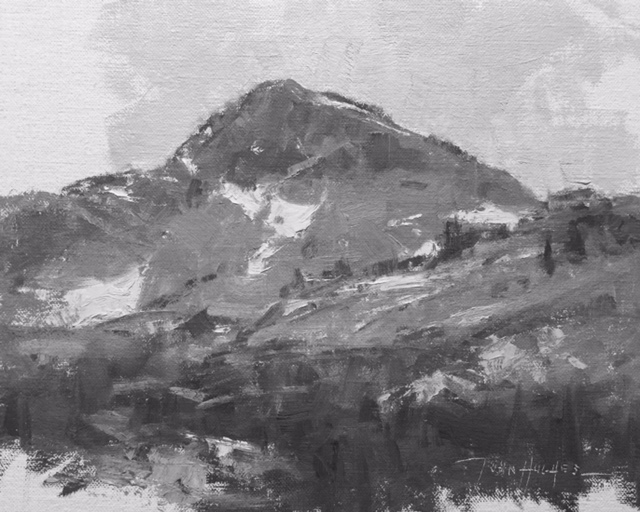
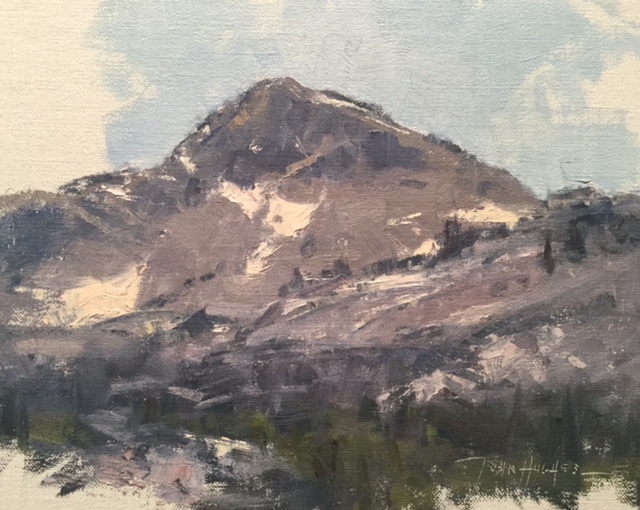
The process is pretty straight forward; place your main darks first in order to establish a value key; this will give you something accurate to relate all the other values to. The placement of your mid-tones and lights can follow. It’s important to mentally approach your subject as a series of lights, darks and mid-tones, which are viewed as interlocking abstractions rather than details of the scene. In other words, don’t think tree or rock, think shape, size, color, color temperature, color saturation, and quality of edge. These marks will eventually become the tree or rock if you follow this new way of seeing, but it takes discipline to keep from falling into the “things” trap. Just put paint down, and fight the urge for as long as possible; then you can slowly switch your thought process to what the scene is really about, as you get closer to the end of the painting.
This all sounds logical and easy to follow, sort of like painting by the numbers, but most never get it, because of pre-conceived notions about what the painting process is. This is where a novice will try for technique, stippling a painting to death in a failed attempt to create leaves on a tree, rather than the color and value so important to the look of the tree. A few details, such as leaves are easy to put on later, but these should never form the basis of your depiction; details will never save a poorly thought-out design.
Will you be one of those who hear about this, and then still go about your painting as though you never read this information, or will you be one of the ones who is willing to take a risk and change your whole way of thinking? The choice is yours, but don’t expect it to happen automatically or overnight. It may be a struggle at first, since new ideas are not always easy to assimilate, but the rewards will be great if you stick with it!
Now some final thoughts on scene selection. This was saved for last, but realistically will be the first thing you do as a landscape painter. I saved it for last, because so many of the abstract pattern considerations that were covered in the painting process are the same things you need to look for in selecting a scene. The only thing that differs in this, is that there are few, if any scenes that are perfectly arranged, ready to paint motifs that the artist can just copy! Nature doesn’t usually accommodate us in that fashion. So instead of trying to find the perfect scene, it is up to us to look for a subject with a number of artistic possibilities that would lend themselves to a creative design. The scene itself, will form the nucleus or idea that will almost always need to be rearranged by the artist, to work on a two dimensional surface in square, or rectangular arrangement. It’s up to the artist to take the raw material and turn it into something useful.
Finding a great scene is not always possible if the artist is primarily concerned with comfort. Serious artists will always take the time to walk around and find scenes that have real merit, rather than setting up in a comfortable location, under a convenient palm tree, complete with mint julips for sipping! Although tempting at times, personal comfort should take a back seat to finding compelling designs. Creative designs don’t just fall out of the sky, and adjustments to the main idea must be supplied by the imagination. Designs are defined as shapes and movements that flow, along with value contrasts and colors that work in a cohesive way, which keeps the eye of the beholder craving more.
Remember, that too much unity will create stagnation and result in boredom, and too much contrast leads to visual chaos. There has to be a balance of measures here, in order to excite the mind as well as provide a sense of well being through some subtle repetition in the scene. Good luck! ~John
This article was featured in Plein Air Today, a weekly e-newsletter from Plein Air magazine. To start receiving Plein Air Today for free and discover more advice on how to paint landscapes, click here.




Thank you! You have put very well the whole idea of seeing, actually taking words from my mouth (to students and fellow painters) and rearranging them much better. I would suggest to everyone who reads your article: print it out and nail it to your easel.
Thank you Sunny!
As a beginning painter, I recently looked back at my first paintings from the past winter and realized that I gave no consideration to values. Just went outside, saw something pretty and started painting. Not that it wasn’t fun, but the paintings are less than stellar. Now, as I’ve started to consider values and shapes, I feel a kinship with abstractionists, just as you noted.
Your article packs a ton of useful concepts, and it is timely for this rookie as I transition to a new way of seeing. Thank you for sharing your knowledge!
Sue,I love it when someone figures out a good painting begins with abstraction. Beginning painters aren’t alone in forgetting or not knowing this. Listen to Hughes and probably you will go far (no, this is not a paid advert; I don’t know him, only what he says).
It is so easy to say, “I like that scene, I want to paint it” and not even know what you like about it. It’s not so easy to try to figure out how shapes and values work together in a composition when you have moving light. Stick with it. It does get better.
Sunny, I appreciate your insight and comment!
Thank you for your encouragement!
So glad to hear Sue, thank you for your comment!
Thanks, John! Another stellar article. Well stated! I like to remind my students, what you see first, paint last and what you see last, paint first.” Meaning, the first things we usually see in a scene are all the details and the last things we see (or don’t see at all) is all the stuff underneath the details.
Hi Rob, Great comment and advice to your students! Thanks for commenting my friend!
Thank you for this timely reminder. I do need to print this out.
Thank you Chris!
Great article! As a veteran artist, I still forget these things. Thanks for the articulate reminder!
What a great article. I started to paint 3 years ago and I used to do exactly what the article said when selecting a scene. I would paint because I liked it.
Then, after many lessons from an online art academy with Barry John Raybould focused on learning notan, value studies using 3-5 values and linking value shapes, I slowly began to understand the painting was about interesting composition and value shape organization. Of course there were other aspects such as visual music and poetry but the value thing was significant.
I still struggle at times seeing and simplifying the values and shapes in the plein air efforts but at least I now have an idea of what I should be looking for. This article reinforced this very well and affirmed what I need to be focused on.
One suggested point, the value studies referenced here seem to be greyscale versions of the color studies. Still helpful for illustrative reinforcement but it would have been a bit more informative seeing actual preliminary studies and maybe the referenced scene. I understand you can only do so much in an article though and it was a very good article as is. Thank you.
Dena and Kevin, Thank you for taking the time to comment. I appreciate the feedback! John-
This was an exceptionally well written piece. I shortened something you wrote to, “The real challenge is not to just see differently, but to be able to artistically select a subject and then paint differently as well.” …a real gem, and I saved to my archive.
I also think it’s a good idea to see all of one’s plein air paintings as “field sketches,” and then if they’re successful, call them plein airs and dignify them with a frame and a title😉.
Thank you Bruce, Good observation; thanks for commenting!